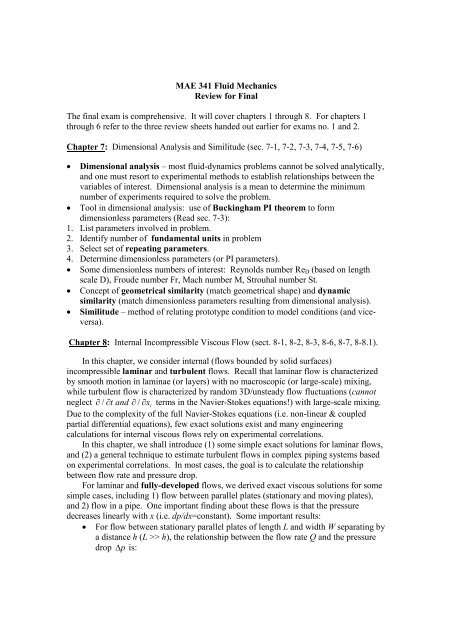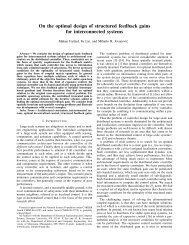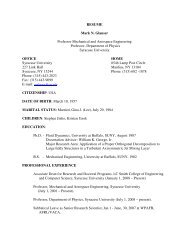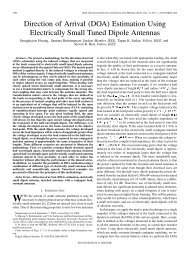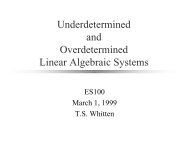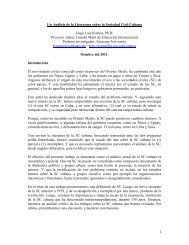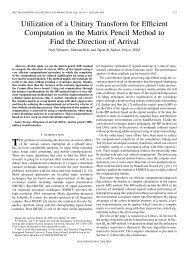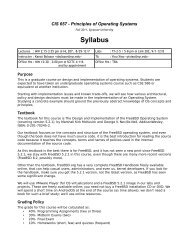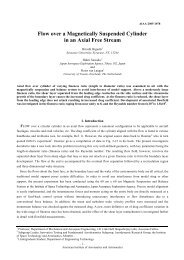MAE 341 Fluid Mechanics Review for Final The final exam is ...
MAE 341 Fluid Mechanics Review for Final The final exam is ...
MAE 341 Fluid Mechanics Review for Final The final exam is ...
Create successful ePaper yourself
Turn your PDF publications into a flip-book with our unique Google optimized e-Paper software.
<strong>MAE</strong> <strong>341</strong> <strong>Fluid</strong> <strong>Mechanics</strong><strong>Review</strong> <strong>for</strong> <strong>Final</strong><strong>The</strong> <strong>final</strong> <strong>exam</strong> <strong>is</strong> comprehensive. It will cover chapters 1 through 8. For chapters 1through 6 refer to the three review sheets handed out earlier <strong>for</strong> <strong>exam</strong>s no. 1 and 2.Chapter 7: Dimensional Analys<strong>is</strong> and Similitude (sec. 7-1, 7-2, 7-3, 7-4, 7-5, 7-6)• Dimensional analys<strong>is</strong> – most fluid-dynamics problems cannot be solved analytically,and one must resort to experimental methods to establ<strong>is</strong>h relationships between thevariables of interest. Dimensional analys<strong>is</strong> <strong>is</strong> a mean to determine the minimumnumber of experiments required to solve the problem.• Tool in dimensional analys<strong>is</strong>: use of Buckingham PI theorem to <strong>for</strong>mdimensionless parameters (Read sec. 7-3):1. L<strong>is</strong>t parameters involved in problem.2. Identify number of fundamental units in problem3. Select set of repeating parameters.4. Determine dimensionless parameters (or PI parameters).• Some dimensionless numbers of interest: Reynolds number Re D (based on lengthscale D), Froude number Fr, Mach number M, Strouhal number St.• Concept of geometrical similarity (match geometrical shape) and dynamicsimilarity (match dimensionless parameters resulting from dimensional analys<strong>is</strong>).• Similitude – method of relating prototype condition to model conditions (and viceversa).Chapter 8: Internal Incompressible V<strong>is</strong>cous Flow (sect. 8-1, 8-2, 8-3, 8-6, 8-7, 8-8.1).In th<strong>is</strong> chapter, we consider internal (flows bounded by solid surfaces)incompressible laminar and turbulent flows. Recall that laminar flow <strong>is</strong> characterizedby smooth motion in laminae (or layers) with no macroscopic (or large-scale) mixing,while turbulent flow <strong>is</strong> characterized by random 3D/unsteady flow fluctuations (cannotneglect / tand / x iterms in the Navier-Stokes equations!) with large-scale mixing.Due to the complexity of the full Navier-Stokes equations (i.e. non-linear & coupledpartial differential equations), few exact solutions ex<strong>is</strong>t and many engineeringcalculations <strong>for</strong> internal v<strong>is</strong>cous flows rely on experimental correlations.In th<strong>is</strong> chapter, we shall introduce (1) some simple exact solutions <strong>for</strong> laminar flows,and (2) a general technique to estimate turbulent flows in complex piping systems basedon experimental correlations. In most cases, the goal <strong>is</strong> to calculate the relationshipbetween flow rate and pressure drop.For laminar and fully-developed flows, we derived exact v<strong>is</strong>cous solutions <strong>for</strong> somesimple cases, including 1) flow between parallel plates (stationary and moving plates),and 2) flow in a pipe. One important finding about these flows <strong>is</strong> that the pressuredecreases linearly with x (i.e. dp/dx=constant). Some important results:• For flow between stationary parallel plates of length L and width W separating bya d<strong>is</strong>tance h (L >> h), the relationship between the flow rate Q and the pressuredrop p <strong>is</strong>:
3Q h p=(8.6c)W 12µL• For flow between parallel plates (one stationary and one moving with speed U),we have:3Q Uh h dp= (8.9b)W 2 12µ dx• For flow in a pipe of diameter D, we have:D pQ = 4128 µL(8.13c)Using the abover result, we can express the head loss h lin terms of the frictionfactor f lam<strong>for</strong> laminar flow as:2pL Vhl = flamwhere f lam= 64DVand Re =D 2ReµApplications of these exact solutions <strong>for</strong> laminar flows are limited to low Reynoldsnumber flows such as lubrication. Recall that the Reynolds number Re <strong>is</strong> a measure ofthe inertial <strong>for</strong>ce over the v<strong>is</strong>cous <strong>for</strong>ce.For most applications, the flow <strong>is</strong> turbulent and no exact solution ex<strong>is</strong>ts even <strong>for</strong>the simplest geometry. We must resort to experimental correlations to tackle theseproblems. For flows in complex piping systems, the energy equation <strong>is</strong> employed. Ittakes on the <strong>for</strong>m:22 p1V1 p2V2 + 1+ gz1 + 2+ gz2 = h lT(8.28) 2 2 where 1 1 and 2 1 (<strong>for</strong> turbulent flow), and h lT<strong>is</strong> the total head loss which <strong>is</strong>determined from experimental correlations. In general, the total head loss <strong>is</strong> expressed as222 L V L= +e , n VnVmhlTff + Km D 2 n D 2 m 2 where the first term on the RHS represents the major loss due to the straight pipesections, and the second term in parenthes<strong>is</strong> on the RHS represents the minor losses dueto pipe entrance, contraction/expansion sections, valves, elbows, bends, etc … <strong>The</strong>major loss <strong>is</strong> expressed in terms of the friction factor f which can be obtained from Fig.8.12 (pg. 339). In general, the friction factor <strong>is</strong> a function of the Reynolds number Reand the roughness ratio e/D. Figure 8.14 indicates that <strong>for</strong> rough pipes, the frictionfactor f <strong>is</strong> a weak function of Re. <strong>The</strong> minor losses weak functions of Re, and are oftenexpressed in terms of an “equivalent” pipe length L eor a loss coefficient K . <strong>The</strong>separameters are determined from tabulated tables and curves. Please read section 8-8 onhow to solve single-path pipe flow problems.<strong>Final</strong>ly, if v<strong>is</strong>cous loss <strong>is</strong> neglected, i.e. h lT =0, Eq. (8.28) reduces to the Bernoulliequation.
Chapter 9: External Incompressible V<strong>is</strong>cous Flow (sect. 9-1, 9-7).In th<strong>is</strong> chapter, we consider external (flows over bodies immersed in an unboundedfluid) incompressible laminar and turbulent flows. <strong>The</strong> goal <strong>is</strong> to calculate the drag<strong>for</strong>ce over the body. Again, due to the complexity of the governing flow equations (i.e.the Navier-Stokes equations), few exact solutions ex<strong>is</strong>t and many engineeringcalculations <strong>for</strong> v<strong>is</strong>cous flows rely on experimental correlations. In th<strong>is</strong> chapter, we shallintroduce (1) a simple exact solution to illustrate the difficulties associated with solvingthe Navier-Stokes equations, and (2) a general technique to estimate drag <strong>for</strong>ce overcomplex geometry based on experimental correlations.We first consider the flow over a stationary flat plate where we introduce theboundary-layer concept. Here, the flowfield <strong>is</strong> divided into two regions. Near thesurface, both v<strong>is</strong>cous <strong>for</strong>ce and inertia <strong>for</strong>ce are important, and the velocity varies fromzero at the surface (due to the no-slip condition) to the freestream velocity at the edge ofthe region – the so-called boundary layer region. Outside the boundary layer region, theflow can be assumed inv<strong>is</strong>cid – the so-called inv<strong>is</strong>cid flow region. In a boundary-layerapproximation, we assume that the boundary layer thickness <strong>is</strong> thin. For laminar flow,it can be shown that the scaling of the boundary layer thickness <strong>is</strong> as follows: 1Ux where Rex12 /x RexµMost external-flow applications have “large” Reynolds numbers (Re >> 1). If the body <strong>is</strong>a streamlined body, the boundary layer approximation <strong>is</strong> very accurate (e.g. flow overan airfoil near the design condition). For bodies that are not streamlined (or bluffbodies), large separated region ex<strong>is</strong>t near the surface and the boundary layerapproximation does not apply here (e.g. flow over a cylinder).For laminar flow over a flat plate in the absence of a pressure gradient (i.e. thestatic pressure in the inv<strong>is</strong>cid-flow region <strong>is</strong> constant), the Navier-Stokes equation can besolved analytically. <strong>The</strong> exact solution yields the following key results: 5UxBoundary layer thickness:= Re/x (9.13)12x RexµD 1328 .ULDrag coefficient:CD = Re/L(9.33)1122U AReLµ2where A <strong>is</strong> the total surface area in contact with the fluid. For a flat plate, A=LW whereL and W are the length and width of the flat plate, respectively. Note that the aboveresults are applicable in the range of roughly Re L 10 5 .As be<strong>for</strong>e, <strong>for</strong> turbulent flows, there ex<strong>is</strong>ts no exact solution even <strong>for</strong> the simplestflow, and we must rely on experimental correlations to estimate drag <strong>for</strong>ce. Usingdimensional analys<strong>is</strong>, it <strong>is</strong> possible to tabulate test data <strong>for</strong> various geometries of practicalinterest (e.g. flat plate, cylinder, sphere, d<strong>is</strong>k). In many cases, it can be shown that thedrag coefficient <strong>is</strong> at most a function of the Reynolds number.
For a flat plate, assuming fully turbulent flow over the flat plate, variouscorrelations <strong>for</strong> drag coefficient ex<strong>is</strong>t. One such correlation <strong>is</strong> (see also Fig. 9.8 on page5 7440 – valid <strong>for</strong> 5× 10 < Re L< 10 ): 0.382Boundary layer thickness:=x Re (9.26)15 /xD 0074 .Drag coefficient:CD =(9.34)1152U ARe /L2Note the difference in the scaling of C D with Re L between laminar flow (power 1/2) andturbulent flow (power 1/5). Using the above results, we see thatturb310 /CDturb,310 /= 0. 0764 Rex= 0. 0557 ReLClamDlam ,For a typical application in the turbulent flow regime with Re = 50 L. × 106 , the aboveresult shows that CD, turb/ CD,lam= 5.7 . Clearly, use of the laminar-flow result in theturbulent-flow regime would have underestimated the drag <strong>for</strong>ce by a factor of 5.7!For flows over bluff bodies, it turns out that the effect of Reynolds number <strong>is</strong>weak <strong>for</strong> many geometries, and the drag coefficient (usually normalized to the frontalarea A) <strong>is</strong> a constant over a wide range of Reynolds number of practical interest (e.g.Table 9.3 on page 443). For <strong>exam</strong>ple, <strong>for</strong> a d<strong>is</strong>k, the drag coefficient <strong>is</strong> C D =1.17 <strong>for</strong>Re D >10 3 (frontal area <strong>is</strong> D 2 / 4 ). <strong>The</strong> drag over some bluff-body geometries such as asphere (Fig. 9.11 on page 444) and a cylinder (Fig. 9.13 on page 446) does depend on theReynolds number.


